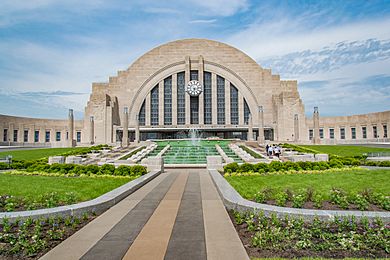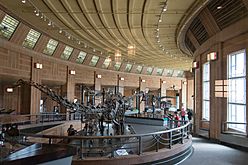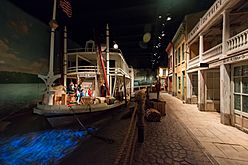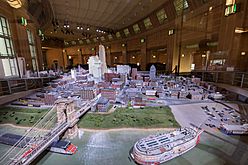Cincinnati Museum Center facts for kids

Main (east) facade
|
|
| Established | January 1995 |
|---|---|
| Location | 1301 Western Avenue Cincinnati, OH |
| Type | General interest |
| Accreditation | American Alliance of Museums |
| Collection size | 40,000 historical objects, 1,500 works of fine art |
| Visitors | 1.8 million (2019) |
| Architect | Fellheimer & Wagner |
| Public transit access | |
| Nearest parking | On site, variable fee |
The Cincinnati Museum Center is a super cool place in Cincinnati, Ohio. It's a big building called the Cincinnati Union Terminal. Inside, you'll find several museums, a theater, a library, and even a huge pipe organ! They also have special shows that travel from other places.
Contents
Exploring the Museums
The Cincinnati Museum Center is home to five amazing organizations:
- Cincinnati History Museum
- Museum of Natural History & Science
- Robert D. Lindner Family Omnimax Theater
- Cincinnati History Library and Archives
- Duke Energy Children's Museum
Museum of Natural History & Science
The Museum of Natural History & Science has a special area called Dinosaur Hall. Here, you can see real skeletons and fossils of dinosaurs. Some of these include the Galeamopus, Daspletosaurus, and Torvosaurus dinosaurs. The Torvosaurus skeleton was put on display in 2018. It's the most complete Torvosaurus skeleton ever found, about 55% complete! It's also the only one you can see in public.
The natural history museum also has a cool copy of a limestone cave. This exhibit is called "The Cave." It was first built in 1967 and was updated around 1994. The cave looks like Mammoth Cave National Park in Kentucky, which is the longest cave system in the world. Workers who knew a lot about caves helped build it using a special spray concrete called gunite. The exhibit has two levels and is 500 feet long. It even has an underground stream and tall, deep holes called dome pits. One of these pits is 40 feet high!
Special Exhibits
Every year, the museum center hosts an event called Holiday Junction. It's a fun, rail-themed event that celebrates trains and holidays.
History of the Museum Center
The idea for the Cincinnati Museum Center started in the early 1980s. The Cincinnati Historical Society and the Cincinnati Museum of Natural History both needed bigger spaces. They realized that the Cincinnati Union Terminal building would be a perfect new home.
In May 1986, people in the local county voted to give $33 million to turn the terminal into a museum. The state of Ohio and the city also helped with money. Many people and businesses donated too. A famous TV host, Jerry Springer, helped convince people to save the building. The terminal had 200,000 square feet of underground space, which was used for parking. This space, along with old taxi and bus ramps, was changed into exhibit areas. The main hall was made new again, and the theater was fixed up. The old train entrance became the Omnimax theater.
In 1986, a group called the Union Terminal Association (UTA) was formed. Their goal was to protect the terminal for a long time. The UTA worked with the Historical Society and Museum of Natural History to create the Heritage Center at Union Terminal.
The first exhibit shown in the terminal was "U.S.S.R.: Individual, Family, Society" in February 1988. This was part of a cultural agreement between the US and the Soviet Union.
The museum center officially opened on November 10, 1990. Its "grand opening day" was November 2, 1991, when the first permanent exhibits opened. At first, it included the Cincinnati Historical Society Library, Cincinnati History Museum, Cincinnati Museum of Natural History, and the Robert D. Lindner Family Omnimax Theater. When it opened, it had the largest display of robot dinosaurs and one of the biggest World War II exhibits. It also had one of only fourteen Omnimax theaters in the United States. The museum quickly became a very popular place to visit. In 1995, all these groups officially joined together to form the Cincinnati Museum Center. The Cinergy Children's Museum also joined in October 1998.
From July 2016 to November 2018, the museum closed for a huge renovation. This project cost $228 million! Voters in Hamilton County approved a sales tax increase to help pay for it. The renovation fixed up the entire building and restored many original rooms. It was the first full renovation of the building. During the closure, all the museum's items were kept safe at a special research and storage facility. Some items even traveled to other exhibits around the country.
The building and museum center had their grand reopening on November 17, 2018. New food places opened inside, offering pizzas, coffee, sandwiches, and ice cream. In January 2019, another museum, the Nancy & David Wolf Holocaust and Humanity Center, opened in the terminal.
Events and Visitors
The museum center hosts many exciting events. One of the biggest is its annual 1940s Day. This celebration happens every year on the second weekend in August. It includes a classic car show, swing dancing, big band music, and a vintage costume contest. The museum started these 1940s parties in 2008 to celebrate the terminal's 75th anniversary. The 1940s were a very busy time for Union Terminal, especially during World War II.
The museum center is also a popular place for important speakers. Many famous people have given speeches there. For example, in 2016, Hillary Clinton spoke there. Mitt Romney held his first presidential rally there in 2012. Barack Obama discussed healthcare at the museum in 2008. John Kerry gave a speech in 2004. In 2002, President George W. Bush spoke about the war in Iraq. More recently, Joe Biden gave a speech at the terminal in 2020.
Besides speeches, other important people have visited. Vice President Dan Quayle visited in 1991. President Dwight D. Eisenhower was greeted by the public in 1952. President Harry S. Truman visited the terminal five times between 1948 and 1952. And Franklin D. Roosevelt visited in 1936.
Museum Collections
The museum center has a special collection of items related to the Union Terminal itself. This includes original drawings by the architects, the silver tool used when the first stone was laid in 1931, and the gold key used to open the terminal in 1933. They also have old photos of the terminal being built, records from the Union Terminal Company, and menus from the restaurants that used to be there.
The Grand E.M. Skinner Concert Organ
The Grand E.M. Skinner Concert Organ is a very special musical instrument. It's made from parts of two older organs. The main part came from an organ that was in a church in Philadelphia. The other part came from a smaller organ that was in Powel Crosley Jr.'s home in Cincinnati. Both of these organs were built in 1929, the same year the Union Terminal building started being built. The main organ was sold to the museum center in 1987. It was installed during the museum's renovations in the 1990s. You can hear its beautiful music from hidden spots around the terminal!
Images for kids








